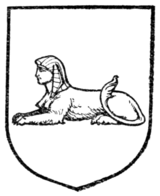a charge upon a shield. It is, however, to be found in the arms of Otway, and is assigned as a crest to the family of Tregent, and a family of Robertson, of London.
The Mermaid (Fig. 434), is much more frequently met with. It is generally represented with the traditional mirror and comb in the hands. It will be found appearing, for example, in the arms of Ellis, of Glasfryn, co. Monmouth. The crest of Mason, used without authority by the founder of Mason's College, led to its inclusion in the arms of the University of Birmingham. It will also be found as the crest of Rutherford and many other families.
The Melusine, i.e. a mermaid with two tails disposed on either side, though not unknown in British heraldry, is more frequent in German.
 Fig. 433.—Merman. |
 Fig. 434.—Mermaid. |
 Fig. 435.—Sphinx. |
 Fig. 436.—Centaur. |
The Sphinx, of course originally derived from the Egyptian figure, has the body, legs, and tail of a lion conjoined to the breasts, head, and face of a woman (Fig. 435). As a charge it occurs in the arms of Cochrane and Cameron of Fassiefern. This last-mentioned coat affords a striking example of the over-elaboration to be found in so many of the grants which owe their origin to the Peninsular War and the other "fightings" in which England was engaged at the period. A winged sphinx is the crest of a family of the name of Asgile. Two sphinxes were granted as supporters to the late Sir Edward Malet, G.C.B.
The Centaur (Fig. 436)—the familiar fabulous animal, half man, half horse—is sometimes represented carrying a bow and arrow, when it is called a "sagittarius." It is not infrequently met with in heraldry, though it is to be found more often in Continental than in English blazonry. In its "sagittarius" form it is sculptured on a column in the Romanesque cloister of St. Aubin at Angers. It will be found as the crest of most families named Lambert, and it was one of the supporters of
